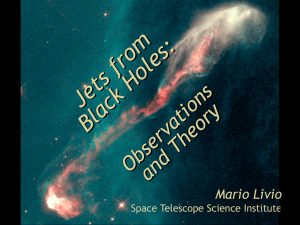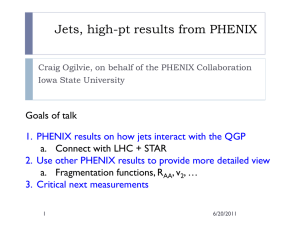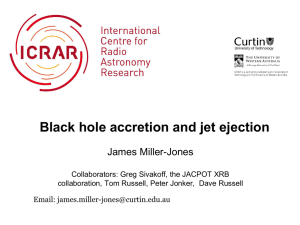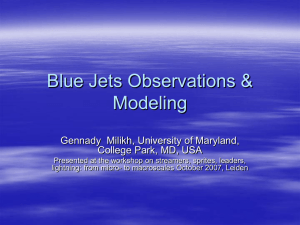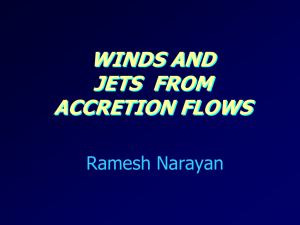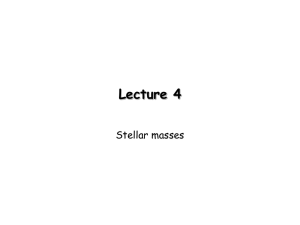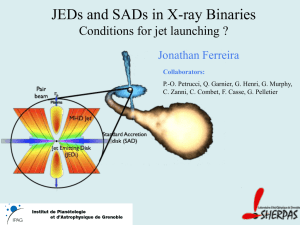Simulations of Jets from Black
advertisement
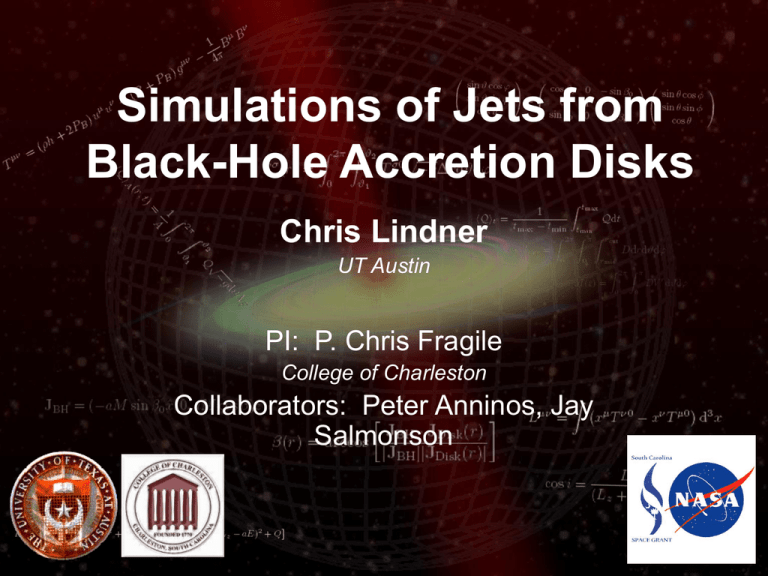
Simulations of Jets from Black-Hole Accretion Disks Chris Lindner UT Austin PI: P. Chris Fragile College of Charleston Collaborators: Peter Anninos, Jay Salmonson Relativistic Jets •High Speed •High Energy •Observable in X-Ray and sometimes even visible and radio spectrums Images courtesy of NASA and ATNF PKS 2356-61 NGC 4261 Radio and visible image Radio and visible image M87 Hubble Space Telescope Visible Relativistic Jets Crab Nebula Jet from a Neutron Star Active Galaxy Centaurus A Minkowski’s Object Radio emissions overlaid in red Jet from an AGN Black Hole • End of a star’s life • Gravity bends light around it • It bends to the point where no light can escape! • Can be found at the center of almost every galaxy Accretion disks • We can’t “see” black holes… • …but we can study how their gravity affects the objects around them Black Hole Accretion Disk Systems • X-ray binary star systems and galaxy nuclei • Black hole accretes matter from donor star • Disk of plasma forms around black hole • Angular momentum is exchanged through Magnetic fields • Magnetically dominated flux points away from black hole’s poles, forming jets What is a jet? • Poynting Flux Jet – EM jet described by Blandford-Znajek Mechanism located in “evacuated funnel” • Funnel Wall jet – gas-pressure launched material jet surrounding the poyting flux region Hawley & Krolik, 2006 Total Pressure (gas plus magnetic) The Magneto Rotational Instability and Blandford-Znajek Mechanism • Positron-electron pair creation could • Magnetic fields are enhanced via angular momentum transport • Leads to a strong polar magnetic field create spark gaps in B fields, and acceleration of these charges could lead to observed emissions Blandford and Znajek 1977 Jets: What we don’t know What powers the jets? What sets Jet orientation? •Not all jets are perfectly linear •Some form corkscrew patterns, indicating jet precession • Binary systems have been observed where jet orientations don’t match the angular momentum of the accreting object How is the black hole oriented? • Currently, this cannot be determined by observation alone Total intensity image at 4.85 GHz of SS433 Blundell, K. M. & Bowler, M. G., 2004, ApJ, 616, L159 Why do Computational Astrophysics? • Tests the extremes of space that cannot be experimentally recreated • Many vital parameters cannot be observed • Many problems have no exploitable symmetry Finite Volume Simulations • Divide the computational area into zones • Each zone contains essential data about the material contained inside • The simulation is evolved in time through a series of time steps • As the simulation progresses, cells communicate with each other – calculate GRMHD Equations in Cosmos++ Extended Artificial Viscosity (eAV) S V t D i DV i t S j i i j ~ ~ t B j i B jV i ~i 2 t ch i B mass conservation 0 1 1 t g B j B0 i g B j Bi 4 4 momentum conservation S S g B B j g g j P PB Q 0 2S 8 ~i B iV j g jk k induction ch2 2 “divergence cleanser” cp Highlights of Cosmos++ • Developers: P. Anninos, P. C. Fragile, J. Salmonson, & S. Murray – Anninos & Fragile (2003) ApJS, 144, 243 – Anninos, Fragile, & Murray (2003) ApJS, 147, 177 – Anninos, Fragile & Salmonson (2005) ApJ, 635, 723 • Multi-dimensional Arbitrary-Lagrange-Eulerian (ALE) fluid dynamics code – 1, 2, or 3D unstructured mesh • Local Adaptive Mesh Refinement (Khokhlov 1998) Highlights of Cosmos++ • Multi-physics code for Astrophysics/Cosmology – Newtonian & GR MHD – Arbitrary spacetime curvature (K. Camarda -> Evolving GRMHD) – Relativistic scalar fields – Radiation transport (Flux-limited diffusion -> Monte Carlo) – Equilibrium & Non-Equilibrium Chemistry (30+ reactions) – Radiative Cooling – Newtonian external & Self-gravity • Developed for large parallel computation – LLNL Thunder, NCSA Teragrid, NASA Columbia, JPL Cosmos, BSC MareNostrum, UT Lonestar, UT Ranger Relativistic Jets in Simulation • Angular momentum supported torus surrounding a rotating black hole • Weak seed dipole magnetic field (poloidal) • Low density background • Minor initial fluctuations to foster instabilities • Mass disk << Mass BH • Simulated for low number of orbital periods Relativistic Jets in Simulation Log Density (~10 orders of magnitude between dark red and blue) McKinney 2005 Magnetic Field Geometry Tilted • Black holes spin • Accretion Disks Spin • Do they have to spin together? • Could this explain jet precession? What determines jet orientation in accretion disk systems? We can answer this question by simulating systems where the angular momentum of the disk is not aligned with the angular momentum of The black hole “Tilted accretion disks” (Fragile, Mathews, & Wilson, 2001, Astrophys. J., 553, 955) •Can arise from asymmetric binary systems •Breaks the main degeneracy in the problem Initial tilted-disk simulations [Show Movies] Initial tilted-disk simulations • Standing shock along “line of nodes” creates accretion streams • Increase in accretion rate • Observable precession • No Bardeen-Petterson effect observed Interesting physics.. but No Jets!!! Spherical-Polar Grid • Most commonly used type of grid for accretion disk simulations – good angular momentum conservation – easy to accommodate event horizon • Not very good for simulating jets in 3D – zones get very small along pole forcing a very small integration timestep – pole is a coordinate singularity • creates problems, particularly for transport of fluid across the pole Cubed-Sphere Grid • Common in atmospheric codes • Not seen as often in astrophysics • Adequate for simulating disks – good angular momentum conservation – easily accommodates event horizon • Advantages for simulating jets – nearly uniform zone sizing over entire grid – no coordinate singularities (except origin) The Cubed Sphere Six cubes are projected into segments of a sphere Each block has its own coordinate system Untilted Disk Jets Magnetic Field Lines Unbound Material Untilted Disk Jets (x10^6 – 6x10^6) DeVilliers, Hawley & Krolik 2004 Scaled as 6 x (Mjet/Mtorus) MassFluxRMax = Blue UnboundMassFlux = Black Possible Issues • Unphysical or physical numerical reconnection • Mass loading • Lack of angular momentum conservation in funnel region • … or maybe previous simulations are too symmetric? Conclusions • Two types of jets: Poynting flux and matter (funnel wall) • Jets do form in MHD simulations – Do not require initial large-scale magnetic fields • Further study is needed in the area of jet orientation and eliminating symmetries (and we’re working on it!) Late time evolution of Gamma Ray Bursts • Light curve decays rapidly in Gamma ray burst • Is it a product of Central engine activity? • Is there enough material to feed a jet? Relativistic Jets in Simulation Plasma β Beckwith, Hawley, and Krolik 2008 Magnetosonic Mach Number Hawley, and Krolik 2005 Untilted Disk Jets Hawley & Krolik 2005 Magnetosonic Mach Number “Late Time” Hawley & Krolik 2005 “Late Time”


